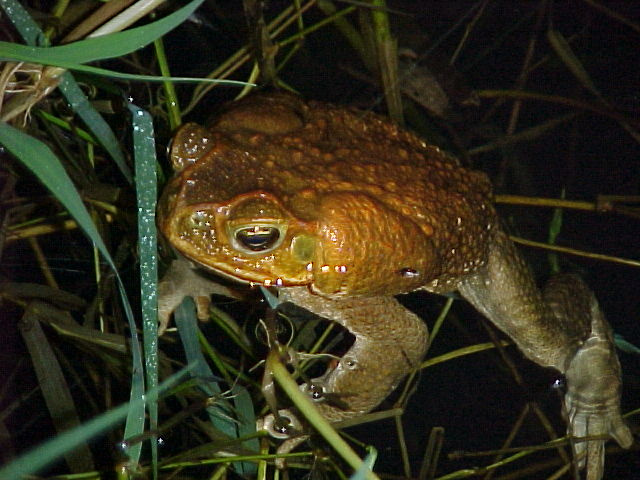Giant Toad or Cane Toad
Giant Toad or Cane Toad (Bufo marinus) Spanish Name: Sapo Neotropical Gigante o Sapo de Caña

More about Cane Toad
Habitat
This toad lives in lowland premontane to lower montane regions up to 2,100 m, and is more common in disturbed areas and human settlement areas.
Range
The Giant Toad can be found from southeastern Texas to the Amazon basin in Peru and Brazil. This species has been introduced by humans to southern Florida, Hawaii, Australia, the West Indies, the Philippines, Taiwan, New Guinea, Fiji, Samoa, and other islands in the south and western Pacific.
Physical Description
This nocturnal toad is difficult to confuse with other species mostly because of its massive size. Another distinct trait is the pair of large, triangularly shaped poison glands (paratoid glands) on the sides of the neck. The Cane Toad also has bony ridges along the top of its head and scattered warts all over its skin. Its body color is brown to olive, with brown splotches on a dirty white or cream underside. It is not the most attractive toad, but its impressive diet and behavior make it an ecologically important species in the Tropics.
Biology and Natural History
The Cane Toad is truly a giant, the largest amphibian in Costa Rica and one of the largest frogs or toads in the world. It has an enormous range and is highly adaptive to different habitats, partly because it can and will eat anything it can.
This amphibian is surviving much better with habitat destruction and climate change than other amphibians. Unlike many frogs and toads, this one is more likely to naturally be found in secondary growth forests or open habitats instead of primary or closed canopy forests. As humans deforested new areas they widened the preferred setting for the Cane Toad. It is now so common in areas used for agriculture or other human needs that it is considered a pest in some regions. It posed a more serious problem in Australia, where the toad was introduced to reduce the beetle populations that damage sugar cane crops. The flaw in this design was that there were no predators in Australia for this large, poisonous toad, so the toad itself became a menace, breeding and dying in water used for livestock and poisoning the herds. Its presence is less harmful in many Central American areas, where the toad can be found under lit areas at night to eat insects.
This toad’s rapid reproduction rate contributes to its abundance. This species breeds all year, and females lay 5,000 to 25,000 eggs at a time, anchoring strings of these eggs to the bottom of a shallow or temporary pool. Although the eggs and tadpoles are toxic, aquatic creatures still eat them. Adults are much more toxic, and although they are still sometimes eaten by crocodiles, other reptiles, birds, or mammals, the glands in an adult contain enough poison to kill large animals. Adults can also eject their poison at an attacker.
One of the toxins in the Cane Toad can cause hallucinogenic responses, making it of interest both to ancient indigenous cultures in Central America and to contemporary scientists. Using the toad by any method is not the best vehicle for hallucinogenic experiences—the human reaction is unpredictable and this toad is potentially lethal.
Diet
The Cane Toad has a remarkably diverse diet, eating anything including insects, spiders, beetles, earthworms, slugs, snails, and ants, and even stinging or toxic prey like wasps, spiders and millipedes; the toad will also eat small vertebrates such as frogs, lizards, mice, and rats. It will consume plant matter and fruit if it needs to, as well as cat and dog food. Large Cane Toads have been known to eat small pets, such as kittens.
Height/Weight
This species tends to be larger in South America and Australia than in Central America. Female Giant Toads can grow to more than 1.5 kg (3.5 lbs) and 90 to 230 mm (9 in). Males are smaller, reaching only 85 to 145 mm in length.
Taxonomy
Order: Anura
Family: Bufonidae
Sources
Savage, Jay M. The Amphibians and Reptiles of Costa Rica: A Herpetofauna between two Continents, between Two Seas. The University of Chicago Press, Chicago, 2002.
Leenders, Twan. A Guide to Amphibians and Reptiles of Costa Rica. Zona Tropical, S.A, Miami, FL, 2001.
Scott, N. J., J. M. Savage, and D. C. Robinson in: Janzen, Daniel H. Costa Rican Natural History. Chicago: University of Chicago Press, 1983.
Amy Strieter, Wildlife Writer
Cane Toad Sightings
Similar Profiles
We believe travel is more than ticking destinations off a list – it’s about discovering new places deeply, feeling connected wherever you go, and knowing you have a trusted team behind you every step of the way.



